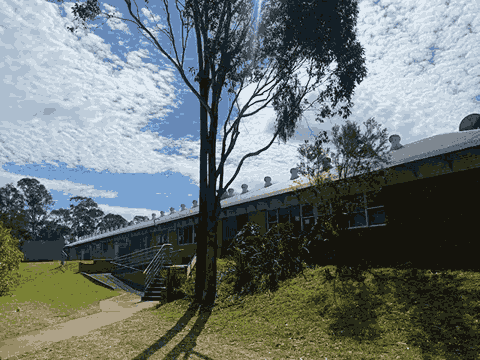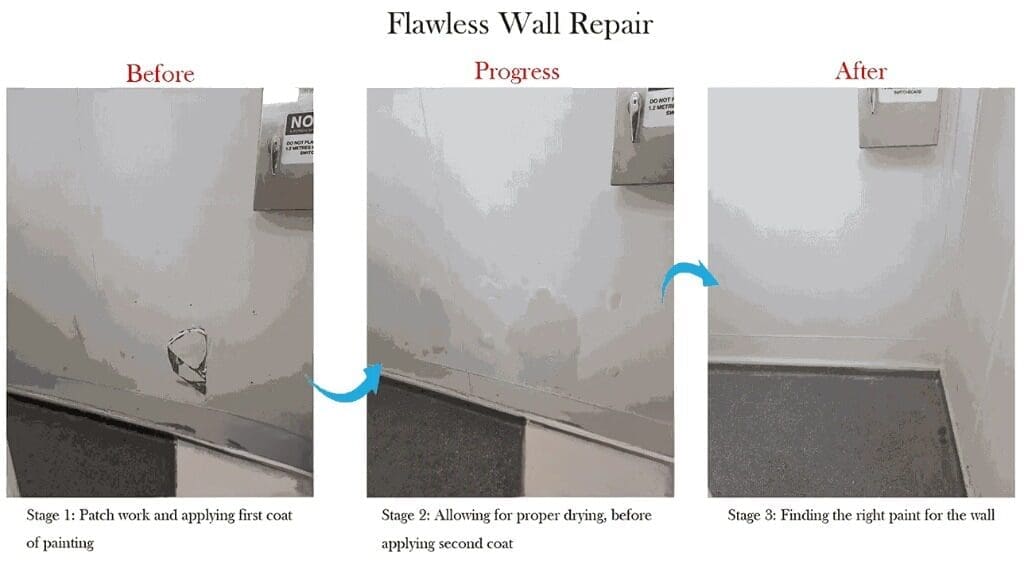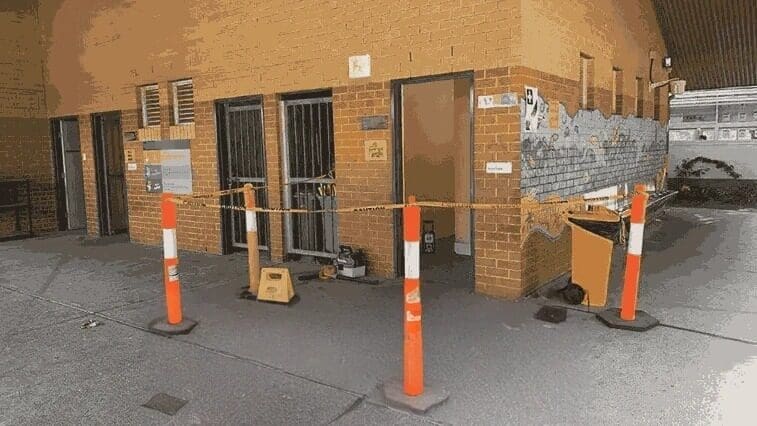In the past year, Sydney Contracting Engineers (SCE) has been engaged by School Infrastructure NSW (SINSW) to respond swiftly to reactive maintenance tasks across Western Sydney schools. The schools include Parklea PS, Hambledon PS, Doonside PS, Riverstone HS, Wyndham College, Quakers Hill HS and Kings Langley PS. The works undertaken ranged from toilet repairs, patching walls, and replacing damaged doors to elevated roofing jobs requiring detailed safety measures. Each job was triaged, assessed, and executed or closed based on feasibility, scope, and contractor capacity. Our approach focuses on responsiveness, technical precision, and clear coordination with school staff and Asset Services Officers (ASOs).
Scope
Across the 7 unique schools listed, SCE delivered:
- Toilet partition replacements and plasterboard patching
- Rust treatment and concrete patching in wet areas
- Fixing doors, locks, and aluminium panels for operability
- Repairing and securing roofing panels, downpipes, and vents
- Replacing broken laminated glass panels
- Conducting safe inspections where access or scope limitations prevented immediate work
Some work orders involved full rectification (e.g., repainting after patching), while others were scoped, quoted, or closed due to work exceeding the handyman scope of works.
Challenges

The reactive nature of the work often meant facing unexpected complications once on site. Jobs that initially seemed minor, such as patching a wall or fixing a door, occasionally revealed deeper structural issues or scope changes that required extra coordination with the school or ASO. Elevated works presented further difficulties, especially where roof access was limited or unsafe without hiring an EWP or larger ladder, which impacted scheduling and resourcing. In some cases, jobs had to be closed or reassigned when they fell outside the handyman scope, such as full plumbing replacements.
Delays also occurred due to environmental factors like wet weather or unavailable power sources needed for drying or tool use. Limited access to colour records or specific materials, like matching tiles or paint, required additional visits. Despite these challenges, SCE remained adaptable, revising plans and communicating regularly with stakeholders to maintain progress and ensure the safe, practical completion of works.
Safety and Environment
SCE upheld strict safety standards on every school site, recognising the heightened risks of working in live environments occupied by students and staff. Before works commenced, asbestos registers were reviewed and exclusion zones were established using bollards, signage, and caution tape. Tasks involving height required harnesses and equipment checks, and where EWPs were used, daily safety protocols were followed closely. These measures ensured a safe work area not only for the team but for the broader school community.
Environmental care was also a focus. Damaged materials were removed responsibly, dust and debris were controlled, and wet areas were treated using appropriate sealing products like Flashcrete or rust converters. All sites were cleaned thoroughly upon completion, with equipment dismantled promptly and any leftover materials such as paint securely handed over to the school for future use.
Quality

Quality workmanship was prioritised across all jobs, regardless of complexity. Each site was inspected thoroughly before any repairs began, and when necessary, scopes were refined to ensure all issues were addressed. For works like wall repairs or glass replacement, jobs were staged to allow for proper drying, curing, or material matching, often requiring two or more visits to ensure the result was both durable and visually consistent with the surrounding area.
SCE’s commitment to quality extended to both materials and methods, using suitable patching compounds, professional paint application, and securing structural elements like backing boards where needed. All works were reviewed in consultation with the GA or school representative and documented appropriately. This approach not only ensured the work met the required standard but also built confidence and trust with both the schools and SINSW.
Community
Working in functioning school environments required a respectful, flexible approach. SCE coordinated closely with General Assistants and school administrators to plan works around student activity, aiming to minimise disruption during classes, assemblies, or exams. On-site, staff maintained a low profile and communicated clearly with school personnel to ensure the work was understood and approved at each stage.
The team consistently left work areas clean, safe, and free of hazards, which helped maintain a positive working relationship with each school. Where relevant, staff shared helpful maintenance tips or left leftover materials with instructions for future use. This collaborative approach contributed to smooth project delivery and reinforced SCE’s reputation as a considerate, professional contractor.
Timeframe
Job durations varied based on complexity. Simple tasks such as door or lock adjustments were typically completed in a single visit, while larger jobs, like wall patching, roof panel replacement, or window glazing required multiple visits due to drying times, safety setup, or the need for custom materials. High-access roofing jobs, particularly those using EWPs, could extend across three to five days including preparation and reinstatement.
Despite these variables, SCE worked efficiently to complete works within a reasonable timeframe. Jobs requiring closure or escalation were assessed and documented promptly, ensuring no unnecessary delays in handover to the relevant contractors. This responsiveness ensured that even complex or evolving tasks progressed smoothly and in alignment with school operational needs.
FAQ
1. What types of external modifications are commonly permitted in Cranebrook?
In Cranebrook, commonly permitted external modifications include additions to homes, such as expanding living spaces, constructing decks and patios, and installing or replacing fencing. Other modifications include building detached garages or sheds, making roofing changes, replacing or adding windows and doors, and undertaking major landscaping alterations like retaining walls. Upgrading or replacing external wall cladding materials for aesthetics or insulation is also allowed. Residents should consult local council guidelines and obtain the necessary permits to ensure compliance with regulations for any planned modifications.
2. What is the process for obtaining approval for structural modifications to a property?
The process for obtaining approval for structural and external modifications to a property typically involves several key steps. First, residents should research local regulations and zoning laws to understand permitted modifications. Consulting with professionals, such as architects or builders, helps ensure compliance with building codes. Next, necessary documentation, including detailed plans and reports, must be prepared and submitted to the local council along with any required fees. The council will then review the application, which may include public notification for feedback. After a decision is made, if approved, residents can begin construction, ensuring adherence to the approved plans and scheduling required inspections. Finally, a completion certificate may be issued following a final inspection to confirm compliance with all regulatory standards.
3. Are there specific building codes and regulations that must be followed for external modifications in Cranebrook?
Yes, specific building codes and regulations must be followed for external modifications in Cranebrook. These include adherence to local council regulations set by the Penrith City Council, which cover zoning laws and land use policies. Modifications must also comply with the Building Code of Australia (BCA), ensuring safety, health, and sustainability standards are met. The Development Control Plans (DCP) provide detailed guidelines on design, setbacks, and height restrictions. Additionally, if the property is in a heritage conservation area, further regulations may apply, alongside environmental planning instruments that address stormwater management and vegetation preservation. Fire safety regulations must also be observed. It is essential for residents to consult the local council and relevant regulations before proceeding with modifications to ensure compliance and avoid penalties.
4. How can residents ensure that their modifications are compliant with local zoning laws?
Residents can ensure their modifications comply with local zoning laws by reviewing the zoning regulations provided by the Penrith City Council, which detail permitted uses, building heights, and setbacks. It is advisable to contact the council for clarification on specific requirements and to engage professionals, such as architects or planners, who are familiar with local zoning laws. Checking the property’s zoning classification using the council’s online tools can help identify any restrictions. Preparing detailed plans that align with zoning requirements and submitting them for pre-assessment to the council can provide valuable feedback before formally applying for permits. Staying informed about any changes in local zoning laws is also crucial to ensuring compliance.
5. What is the expected timeline for the approval process for external modifications?
The expected timeline for the approval process for external modifications in Cranebrook typically spans about 6 to 12 weeks, though this can vary based on the project’s complexity. The initial phase of preparing documentation may take a few days to several weeks. After submission, the local council usually requires 4 to 8 weeks to review the application, which may include consultations and public notifications. Following the review, the council will notify the applicant of its decision within an additional week or two. If modifications are requested, the timeline may extend further as revisions and resubmissions are necessary. It is advisable for residents to check with the local council for specific timelines related to their applications.
6. Are there any fees associated with applying for external modification permits?
Yes, there are fees associated with applying for external modification permits in Cranebrook, which can vary based on factors such as the type and scale of the project. Common fees include a standard application fee, assessment fees for the council’s review, and public notification fees if community consultation is required. Additionally, there may be inspection fees charged for mandatory inspections during and after construction to ensure compliance with regulations. Residents are advised to consult the Penrith City Council’s website or contact them directly for a detailed breakdown of applicable fees for their specific projects.
7. What considerations should be made regarding the impact of modifications on neighbours and the surrounding environment?
When considering modifications, residents should take into account the impact on neighbours and the surrounding environment by assessing several key factors. These include the visual impact of changes and potential obstruction of views, privacy concerns related to new windows or balconies, and noise levels during and after construction. Additionally, it is important to evaluate how modifications may affect natural light and shade on neighbouring properties, as well as ensuring proper stormwater management to prevent flooding or erosion. Residents should also consider the preservation of existing trees and vegetation, the overall community aesthetics, and compliance with local zoning and environmental regulations. Thoughtful consideration of these factors can help minimise negative impacts while enhancing properties.
8. How do external modifications affect property value in Cranebrook?
External modifications can significantly enhance property value in Cranebrook by improving curb appeal, adding functional spaces, and modernising older properties to align with market trends. Upgrades that boost energy efficiency, such as better insulation or energy-efficient windows, also make properties more attractive by lowering utility costs. Additionally, ensuring that modifications comply with local zoning and building regulations helps avoid future legal issues, further enhancing marketability. However, poorly executed modifications that do not fit the neighbourhood’s character may negatively impact value. Overall, well-planned external modifications typically lead to increased property value in Cranebrook.
Thank you for your visit, and welcome to the construction home


